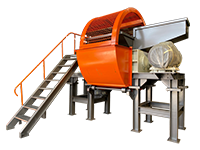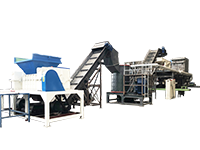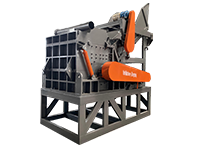For practitioners engaged in scrap recycling and metal processing, choosing the right equipment and using it in the right way is the key to reducing costs and increasing efficiency. As a core equipment in the scrap processing chain, the hydraulic metal baler can fundamentally solve the pain points of "occupying space and high freight costs" during the transportation of scrap metal/paper, and "irregular shapes difficult to handle" before scrap processing. Moreover, if combined with the pretreatment process and professional operation and maintenance ideas, the equipment value can be maximized.
1. First, understand: What problems does the hydraulic metal baler actually solve?
If you often encounter these troubles - scrap metal/paper takes up space and has high freight costs during transportation, scrap is irregular and difficult to handle before processing, or the equipment cannot be used due to limited space and no power supply, then the hydraulic metal baler is a tailor-made solution for you.
Its core function is to press loose scrap into high-density blocks: for example, scrap steel边角料 (side scraps) can be pressed into regular cuboids, and waste paper can be pressed into solid cakes, which not only reduces transportation and storage costs, but also makes subsequent processing (smelting, reuse) more efficient.

2. Choosing the right model = avoiding detours: Quick matching of 3 core models + applicable scenarios
1. Horizontal Hydraulic Baler - "Efficient Processor for Large-Scale Scrap"
• Applicable scenarios: Sites that need to process dozens of tons of scrap steel, scrapped car dismantling materials, or bulk waste paper recycling every day.
• Core advantages: The processing capacity is extremely large (it can press 0.4-8 tons of materials at a time, depending on the model), and it can also be equipped with an automatic feeding device to realize continuous production of "feeding-compression-discharging", suitable for practitioners with stable and large production capacity requirements.
2. Vertical Hydraulic Baler - "Suitable Choice for Small Sites + Light and Thin Materials"
• Applicable scenarios: Recycling sites with small space, or mainly processing light and thin materials such as cans, waste aluminum foil, and scattered waste paper.
• Core advantages: The structure is compact, which does not take up too much space; after pressing light and thin materials into "cakes", storage and short-distance transportation are more convenient.
3. Diesel-Powered Hydraulic Baler - "Life-Saving Option for Sites Without Power Supply"
• Applicable scenarios: Remote recycling points, field scrap processing sites (such as scrap metal recycling at demolition sites).
• Core advantages: No need for electricity, and the hydraulic system can work by driving with a diesel engine. Both scrap metal and waste plastic can be processed, solving the pain point of "unable to start work without power supply".
3. Professional details contain secrets: How to look at the hydraulic system, molds, and safety design?
1. Hydraulic System - "The Key to Whether the Equipment is Durable and Energy-Saving"
• Pump selection: Give priority to models with "variable piston pumps", which can automatically switch between "large flow during feeding (fast efficiency) and high pressure during compression (sufficient force)", which not only saves electricity but also is not easy to break down.
• Hydraulic oil and filtration: Anti-wear hydraulic oil (such as SAE 10W-30 model) must be used, and a filter with an accuracy of ≤10μm must be equipped - if impurities enter the hydraulic system, the subsequent maintenance cost can be several times higher.
2. Molds and Press Heads - "The Core of Material Block Quality + Equipment Life"
• Mold size: It must match the specifications of the material block you want (for example, if you want to press a material block of 39×24×20 inches, the mold must correspond to this size), and the inner wall of the mold must be chrome-plated/nitrided, and the hardness must reach at least HV800, otherwise it will be worn out after a few presses.
• Press head connection: Look for the "spherical structure connection" design. This structure can disperse the stress during extrusion, and the service life of the oil seal and press head can be 30% longer than that of ordinary designs.
3. Safety Design - "The Point That Practitioners Should Pay Most Attention To"
• Dangerous parts (such as near the press head) should be equipped with protective nets and safety switches, and emergency stop buttons must be provided - in case of accidents during operation, the machine can be stopped immediately to ensure personal safety.
• The feeding port should be "widened and enlarged" (such as a feeding port of 20×24 inches), which is more convenient when pouring scrap into it, and there is no need to struggle to "stuff the materials".

4. Cooperating with small metal crushers: Directly maximize pretreatment efficiency
If you are dealing with "large scrap metal" (such as scrapped home appliance casings, thick steel bars), then crushing first and then pressing is a smarter approach:
• The small metal crusher crushes large scrap into fine materials ≤4 inches, and then sends them to the baler for compression. The density of the material block can be increased by 15%-25% compared with direct pressing.
• When selecting a crusher, note: the hammer speed is controlled at 1500-3000 rpm, and the cutter is made of cemented carbide. In this way, whether it is scrap metal with plastic or pure steel, it can be crushed efficiently.
5. Practical selection + operation and maintenance: Follow this to spend less money
(1) Three steps for model selection
1. Calculate the production capacity: First, figure out how many tons of scrap you need to process every day (such as 50 tons or 200 tons per day), and then select the model corresponding to the nominal pressure (such as 90 psi, 145 psi, etc.) and production capacity (0.4-8.0 tons/hour) to avoid waste or insufficiency of production capacity.
2. Check the materials: For enterprises mainly dealing with scrap steel, give priority to models with high rigidity and large nominal pressure; when dealing with light materials such as waste paper and waste plastic, you can focus on models with easy-to-replace molds and adjustable compression stroke to reduce maintenance costs.
3. Check the site: If there is no power supply, you need to choose a diesel-powered model; if the site space is limited, you should give priority to the vertical structure to save space.
(2) Three things for operation and maintenance
1. Regular oil change: Detect the viscosity and cleanliness of the hydraulic oil every 500 hours, and replace the deteriorated or contaminated hydraulic oil in time.
2. Flaw detection inspection: Conduct non-destructive flaw detection (such as ultrasonic flaw detection) on key structures such as the press head and material box to detect cracks and other potential faults in time.
3. Control the feeding amount: Avoid "overloading feeding" which may cause the equipment to jam or deform; at the same time, regularly check the wear of the spherical connection part and maintain or replace the parts in time.
6. Quick Parameter Table of Mainstream Models (Taking YXJD Series as an Example)
| Model No.Model No. | Nominal Pressure (psi) | Package Size (inch) | Single Package Weight (lbs) | Production Capacity (ton/hour) | Power Configuration |
| YXJD-63 90 | 90 | 39×24×20 | 33-66 | 0.4-0.8 | 10 HP |
| YXJD-100 | 145 | 39×28×22 | 66-88 | 0.6-1.2 | 15 HP |
| YXJD-125 | 180 | 47×28×24 | 110-165 | 1.2-1.5 | 20 HP |
| YXJD-400 | 580 | 118×79×47 | 550-836 | 6.8-8.0 | 60 HP×2 |
7. Most Concerned Questions of Practitioners
1. Q: What types of waste can the hydraulic metal baler handle?
A: It can handle scrap steel (reinforcing bars, steel plate side scraps, scrapped steel structures, etc.), non-ferrous scrap metals (aluminum profiles, copper cables, etc.), waste paper, waste plastic, old fabrics and other light waste, but flammable and explosive substances such as residual fuel oil and lithium batteries must be removed in advance.
2. Q: How to choose the crushing粒度 (granularity) of the crusher?
A: The longest side of the crushed scrap should be ≤1/3 of the width of the baler's feeding port (for example, if the feeding port is 24 inches, the longest side after crushing should be ≤8 inches). Too fine will increase the energy consumption of the crusher, and too coarse will affect the baling density.
3. Q: Is the installation really simple?
A: Yes, there is no need for a foundation or to tighten the foot screws; the diesel-powered model can be installed even without a power supply, and the site only needs to be able to place the equipment.
4. Q: What if the model is chosen incorrectly?
A: First, consult the manufacturer, explain your daily processing volume, material type, site conditions, etc., and ask the manufacturer to help adjust or replace accessories (such as changing molds, modifying hydraulic parameters). If it really doesn't work, consider changing the model.
Whether you are a novice or an experienced person in scrap recycling, mastering the selection logic, technical details and coordinated pretreatment ideas of the hydraulic metal baler can take the efficiency and income of the scrap processing link to a new level. If you still have questions about equipment selection, operation and maintenance, or pretreatment solutions, you can further explain your specific scenario (such as daily processing volume, material type, etc.) to get more accurate suggestions.
 Shredding Machine
Shredding Machine
 Waste Recycling Line
Waste Recycling Line
 Optional Equipment
Optional Equipment


